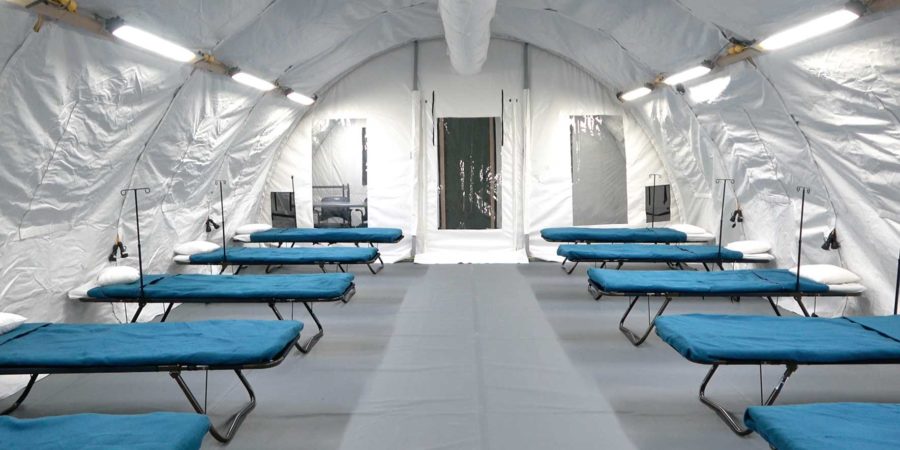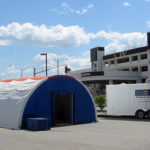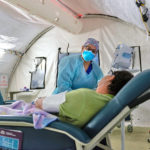Negative Pressure Isolation vs. Positive Pressure Isolation
Since the onslaught of the COVID-19 pandemic, hospitals have been overwhelmed with the staggering number of positive-testing patients.
Many hospitals chose to treat COVID-19 positive patients in mobile field hospitals from BLU-MED Response Systems® to avoid the spread of exposure. This has allowed healthcare personnel to continue safely treating uninfected patients as well.
From COVID-19 testing to vaccine distribution and caring for the infected, healthcare professionals have been working around the clock.
The Centers for Disease Control and Prevention (CDC) requires negative pressure airborne infection isolation (AII) to be used in events of infectious airborne diseases. Implementing negative pressure isolation structures has greatly helped to reduce the spread of the virus.
But how does negative pressure isolation work? And how does it differ from positive pressure isolation? Read on to learn more about the differences.
How Negative Pressure Isolation and Positive Pressure Isolation Differ?
Both positive and negative pressure isolation aid in maintaining sterile environments — an important component for medical response teams to create and maintain a safe environment to treat patients.
But choosing when to use negative pressure isolation versus positive pressure isolation is key.
That’s why BLU-MED provides medical shelters capable of offering both options.
Positive Pressure Isolation
As the name implies, positive pressure isolation units maintain a higher pressure than the surrounding environment, to prevent contaminants from entering the room.
This is highly advantageous for surgery, treating intensive care patients or immuno-compromised patients. In these cases, this kind of pressure isolation
Negative Pressure Isolation
For patients who test positive for airborne illnesses, negative pressure isolation prevents contaminants from escaping from the room. The goal is to maintain save, clean medical wards for infected patients, while preventing pathogens from leaving the ward.
When treating COVID-19 positive patients, medical personnel and other patients are at risk of exposure. To reduce this risk, clean, conditioned air is delivered into the room, but prevented from leaking out through openings or entries. All of the HVAC air passes through a HEPA filter and germicidal filter before being recirculated to the patient care area.
As criteria can change from patient to patient, our designs are adaptable. The negative pressure isolation systems can easily convert into a positive pressure treatment area.
[Related: Key Elements of Pandemic-Ready Healthcare Facilities]
The BLU-MED Difference
As a division of Alaska Structures, BLU-MED carries 46 years of experience into all of its medical shelter and mobile field hospital designs.
Alaska Structures is the preferred supplier for the U.S. Army Combat Support Hospital and the U.S. Air Force Expeditionary Medical Support (EMEDS) program.
To help meet emergency medical needs in the U.S. and around the world, Alaska Structures formed BLU-MED Response Systems in 2004. Now, our medical shelters and mobile hospitals enable communities and emergency management agencies to rapidly respond to disasters.
BLU-MED medical facilities and mobile field hospitals allow organizations to quickly respond when and where they are needed™, providing the safe and clean environment necessary for advanced-level care in any weather conditions, both temporary and permanent.
BLU-MED Negative Pressure Isolation Units
Negative Pressure Isolation shelters from BLU-MED provide safe spaces to screen, isolate, and treat patients. Because COVID-19 spreads quickly, allowing infected patients to enter a hospital puts all other patients and hospital staff at risk.
That is why many have opted for medical shelters being set up outside of the main hospital building using BLU-MED’s state-of-the-art and rapidly deployable medical shelters.
BLU-MED medical shelters can be equipped with negative pressure isolation systems to quarantine and treat infected patients in a temperature-controlled isolation facility.
BLU-MED medical shelters are engineered to withstand 100 mile-per-hour wind gusts and snow loads of up to 20 pounds per square foot, allowing them to be safely used in locations with harsh weather conditions.
What are the Benefits of BLU-MED Negative Pressure Isolation Rooms?
Negative pressure isolation systems for BLU-MED medical shelters and mobile hospitals provide protection against particles, biologicals, and gas phases.
The notable components of a BLU-MED negative pressure isolation system include:
BLU-MED Medical Shelter
BLU-MED medical shelters can be set up on most level surfaces. Depending on the model and shelter size, BLU-MED offers rapidly deployable medical shelters capable of being set up in less than 10 minutes.
BLU-MED medical shelters can be equipped with a large assortment of medical equipment packages and complexed to create 15- to 200-bed mobile hospital layouts.
Lighting and Electrical Systems
Mobile field hospitals and medical shelters from BLU-MED include plug-and-play electrical and lighting systems, providing the ability to power life-saving medical equipment.
BLU-MED offers power generation and distribution systems for creating self-contained mobile field hospitals when shore power is not available or reliable.
Isolation Partitions
To maintain privacy and increase protection against exposure, isolation partitions can be added to any BLU-MED medical shelter. When dealing with an airborne infectious disease or virus, such as COVID-19, isolation partitions can be a critical component to creating a negative pressure space to quarantine and treat infected patients.
Internal Liner and Insulation Systems
In climates with extreme cold or hot temperatures, additional insulation may be necessary for maintaining a comfortable interior temperature. BLU-MED medical facilities can be equipped with internal liner and proprietary insulation systems that increase energy efficiency.
Modular Flooring Systems
To further eliminate outside contaminants, BLU-MED offers a nonslip, vinyl, and vector-proof flooring system for creating a safe, clean space to perform medical procedures. A sub-flooring system is also available to create a smooth and even floor on unimproved surfaces, including gravel, sand, dirt, grass, or snow.
Environmental Control Units (Mil-Spec HVAC Units)
Maintaining a comfortable interior temperature in extreme hot or cold climates for advanced-level care is important for patients and staff. BLU-MED uses the Alaska ECU™, a mil-spec environmental control unit (ECU), to provide heating and cooling capability for any medical shelter or mobile field hospital.
BLU-MED ECUs are portable and are available with U.S. 60 Hertz or EU 50 hertz electrical components. Depending on your heating or cooling requirements, several sizes and models are available. Furthermore, BLU-MED ECUs operate in extreme environments with ambient temperatures between -25˚F to 132˚F.
[Related: The Importance of HVAC Systems for Alternate Care Facilities]
Internal Air Distribution System
Evenly distributing the airflow in a medical shelter or mobile field hospital is important for increasing patient and staff comfort, as well as energy efficiency. BLU-MED offers an internal plenum with adjustable openings to direct and control the airflow within the medical shelter.
When equipped with an air scrubber containing a UV and HEPA germicidal filtration unit, the air distribution system can be used to create a negative or positive pressure environment for filtering and removing harmful viruses and air contaminants.
Negative Pressure Alarm System
BLU-MED isolation shelters feature a negative pressure alarm system that ranges from 0.01 to 0.04 inches SPWG. A visible and audible alarm alerts medical staff if the pressure inside the isolation area drops.
Need a Medical Shelter Equipped With a Negative Pressure Isolation System?
The COVID-19 pandemic has highlighted the need for hospitals and medical facilities to be prepared with hospital surge facilities and systems capable of creating negative pressure isolation rooms, like those from BLU-MED Response Systems.
Let’s discuss how BLU-MED can help prepare your hospital or medical facility with medical shelters and mobile field hospitals for future disasters. Contact us today!


